by Natasha Klimenko // Mar. 15, 2022
This article is part of our feature topic ‘Occupation.’
Ukrainian artists Victoria Pidust and Volo Bevza have lived in Berlin since 2015. Pidust’s work is photography-based and Bevza’s combines oil painting with digital tools. They flew to Kyiv on February 20th for Bevza’s solo show ‘Soft Images’ at the WT Foundation, scheduled to open on February 24th. That morning, the pair woke up in the historic center of Kyiv to explosions in the distance: Russia had invaded Ukraine. They evacuated to Vyshneve, a few kilometers south of the capital, and then to Lviv, close to the Polish-Ukrainian border. Now, they help build anti-tank obstacles and collect funding for the effort and humanitarian support. On the 12th day of the war, I talked to them about their current experiences, the absurdity of the situation and how reality is rebuilt by media.
You can support Victoria and Volo in their defense and humanitarian efforts by donating directly to them. Their fundraising work in Germany is done in cooperation with Galerie Judith Andreae in Bonn.
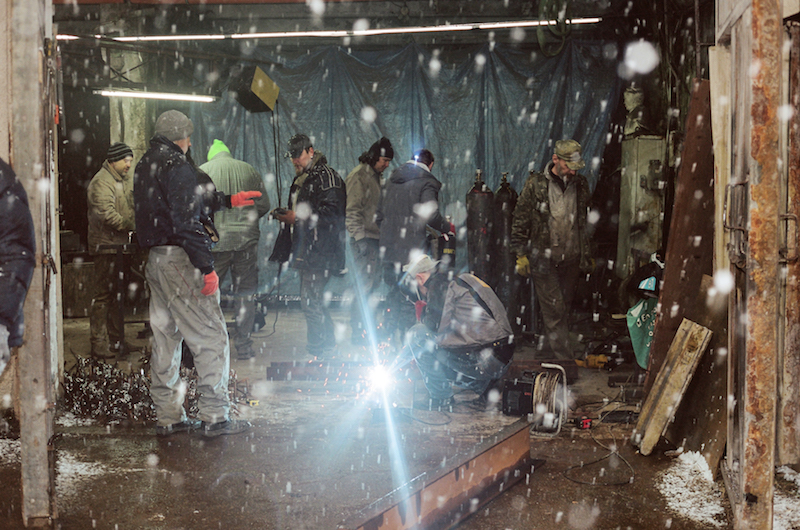
Documentation from the workshop building “hedgehog” anti-tank obstacles, Lviv, 2022 // Photo by Victoria Pidust
Natasha Klimenko: Where are you calling from?
Volo Bevza: We’re staying with my father’s friend in Lviv. He’s an artist. He’s housing almost 24 people. We’re calling from one of his studios, in the cellar. If there’s an airstrike alarm, we come down here. We barricaded the windows.
NK: But it’s relatively safe in Lviv?
VB: As safe as it can be in Ukraine.
Victoria Pidust: But this can change quickly.
VB: Some days, we go to the cellar several times because of the airstrike alarm. Or we might get a notification from the government’s telegram channels.
VP: There are also news channels we follow on Telegram. One is called “Normal News.” It’s absurd to get notifications from a channel called “Normal News” that say, “a Russian bomb destroys a kindergarten,” or, “a family has been killed.”
VB: It’s surreal.
NK: Do you trust the news?
VP: In Ukraine, there isn’t much propaganda. But there are many fakes by the Russian cyber army to disorient people.
NK: Could you give me an example?
VB: Recently, they said that Russian troops invaded Brody, a small city not far from Lviv. A few hours later, it was confirmed as fake, but people here panicked.
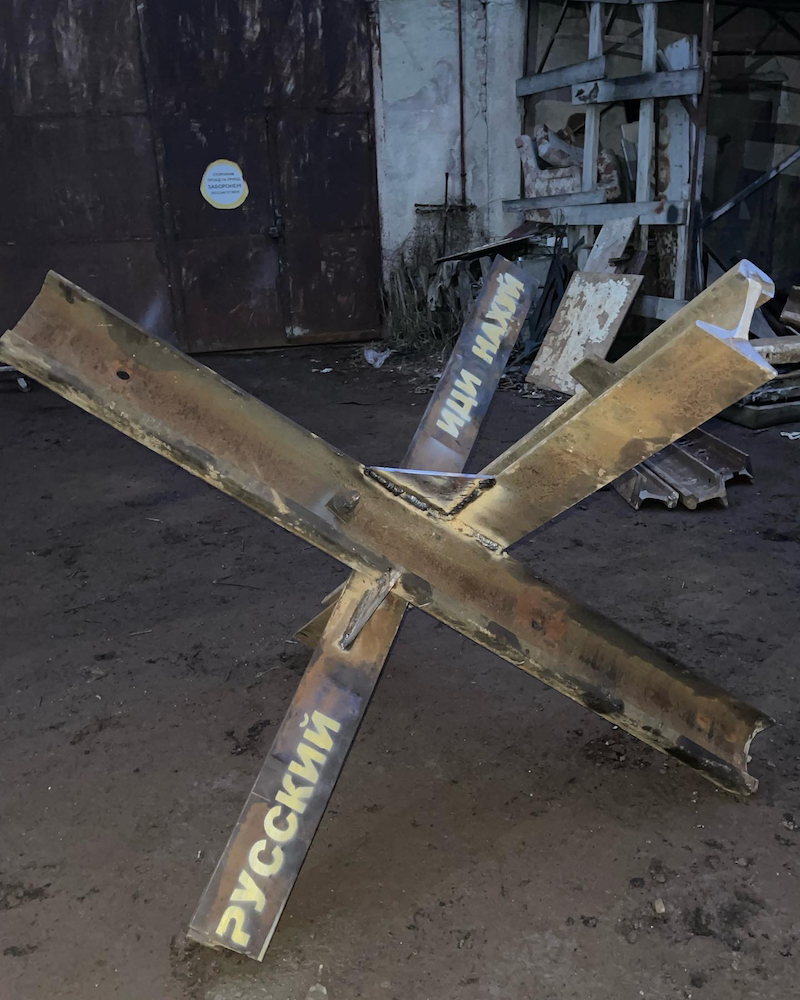
Documentation from the workshop building “hedgehog” anti-tank obstacles, Lviv, 2022 // Photos by Victoria Pidust
NK: In Lviv, you make anti-tank obstacles?
VB: The first day we arrived here we were in shock. Ruslan, our host, showed us a video of people building “hedgehogs,” the anti-tank obstacles. He said it was at a workshop for bronze, ceramic, and metal sculptures nearby. Instantly, we decided we’re ready to help. There wasn’t any name for it, or any organization behind it. It was a private initiative by Roman Andriyovskuy, one of the workshop’s sculptors. Many people joined him. The hedgehogs are going to Kyiv, Kharkiv, the border with Belarus, everywhere. Vici’s brother, Mark, helps with the physical work. We feel better when we can actively do something. Otherwise, we just connect to “Normal News.”
VP: I took photos of the process. Then we started organizing funding. Our contacts in Germany wrote us, asking how they could help. At first, we didn’t know what to say. But the shock wore off, and we realized we were running out of materials, so we started a fundraiser. We bought materials and spent the leftover money on humanitarian aid. We’re thinking about selling editions or artworks to get more financial support. We still don’t know how to reflect on this artistically.
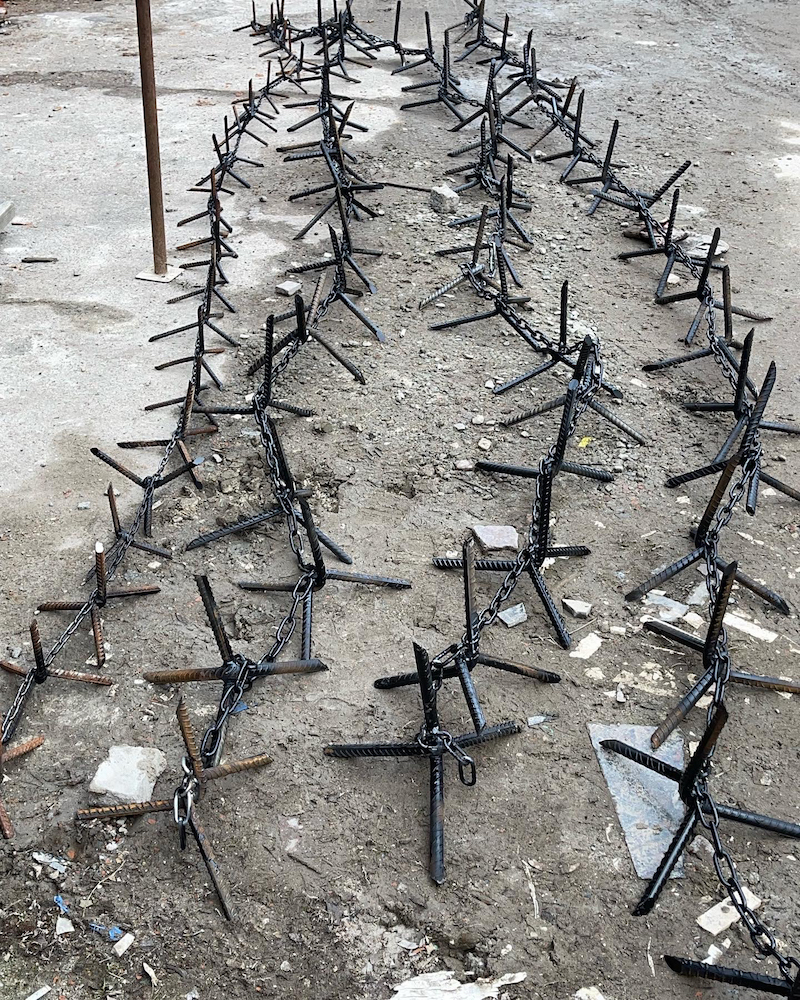
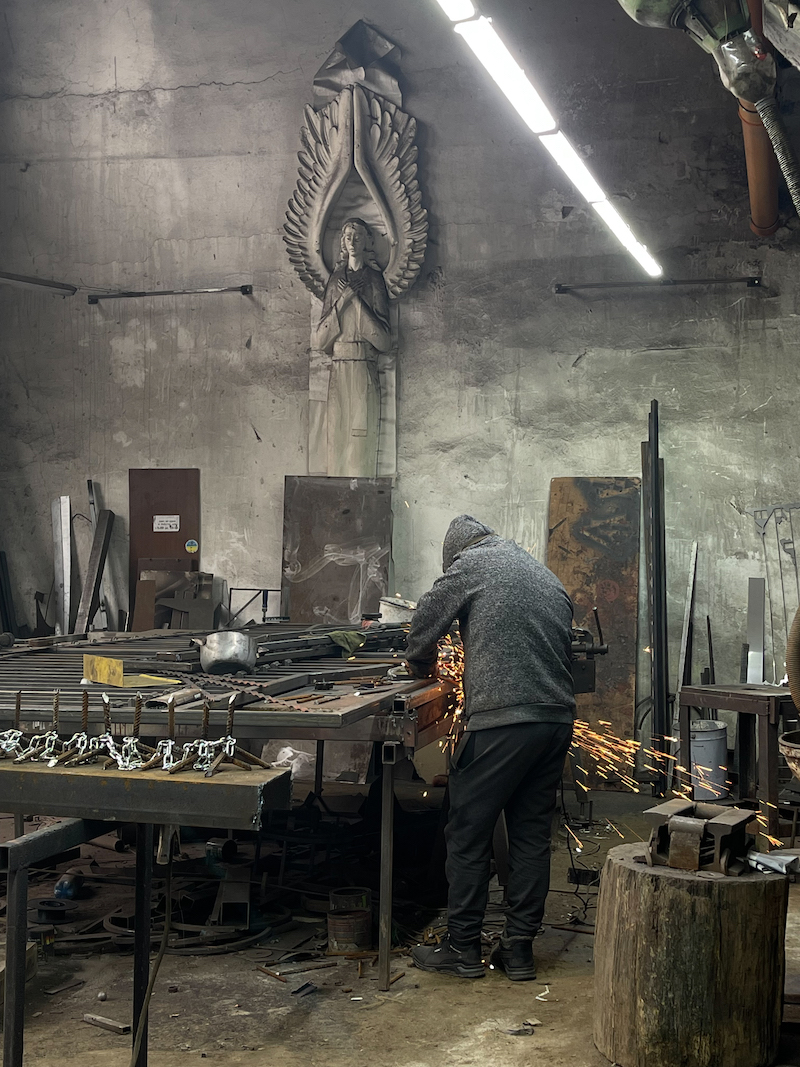
Documentation from the workshop building “hedgehog” anti-tank obstacles, Lviv, 2022 // Photo by Victoria Pidust
NK: Do you see the hedgehog building as a kind of art?
VP: It looks like art, but it’s not.
VB: After the French Revolution, art needed to be meaningless, or useless. If it has a use, it’s not art anymore. Part of the group building the hedgehogs are artists.
VP: The hedgehogs should be precise and uniform. And theirs have different colors, shapes, and sizes.
VB: But their main purpose is to stop tanks.
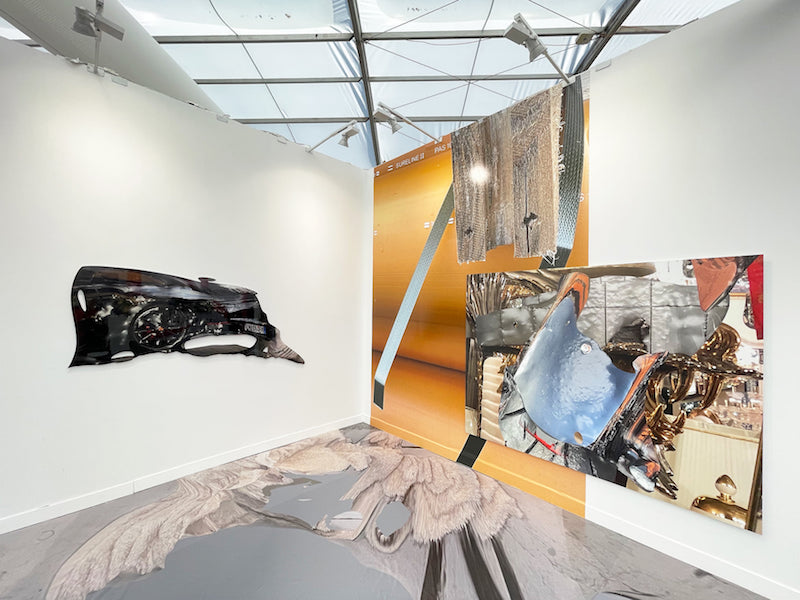
Victoria Pidust, Paris Photo 2021, CURIOSA SECTOR, Solo booth, curated by Shoair Mavlian, presented by Galerie Judith Andreae, Bonn. Left: ‘Porsche,’ 2020; middle: ‘Untitled 39,’ 2021; right: ‘Objects 11,’ 2021; floor: ‘Towel,’ 2021 // Photo credit: Victoria Pidust
NK: Your past work, though, has themes that seem to connect to the war, at least in terms of propaganda and how events are distorted. Your photography, Victoria, considers reality, and how difficult it is to capture.
VP: A lot of my work is about the perception of the viewer, how reality can be destroyed and rebuilt. As a photographer, I think about how easily “reality” can be changed with technology. I work with photogrammetry software. I take photos from different perspectives and place them in a 3D-modelling program, but I make the models with mistakes, not putting in enough images, and the program creates errors and fills in the gaps. For me, it’s very similar to how people think about an object from the surface—you look at an object and you fill it in with your own experiences. But this is only part of the object, you can’t read everything. There are mistakes in perception.
VB: That’s what propaganda does in Russia: it’s a wall to separate people from facts. It destroys and then rebuilds information, makes it into something completely different.
VP: Recently, there was a viral fake with Putin, sitting at a table with women. He’s gesturing, and his hand goes through a microphone. You can see clearly that the people sitting around him were placed there artificially. Our president gave a speech that day and, at the end, in response, he moved the microphone with his hand.
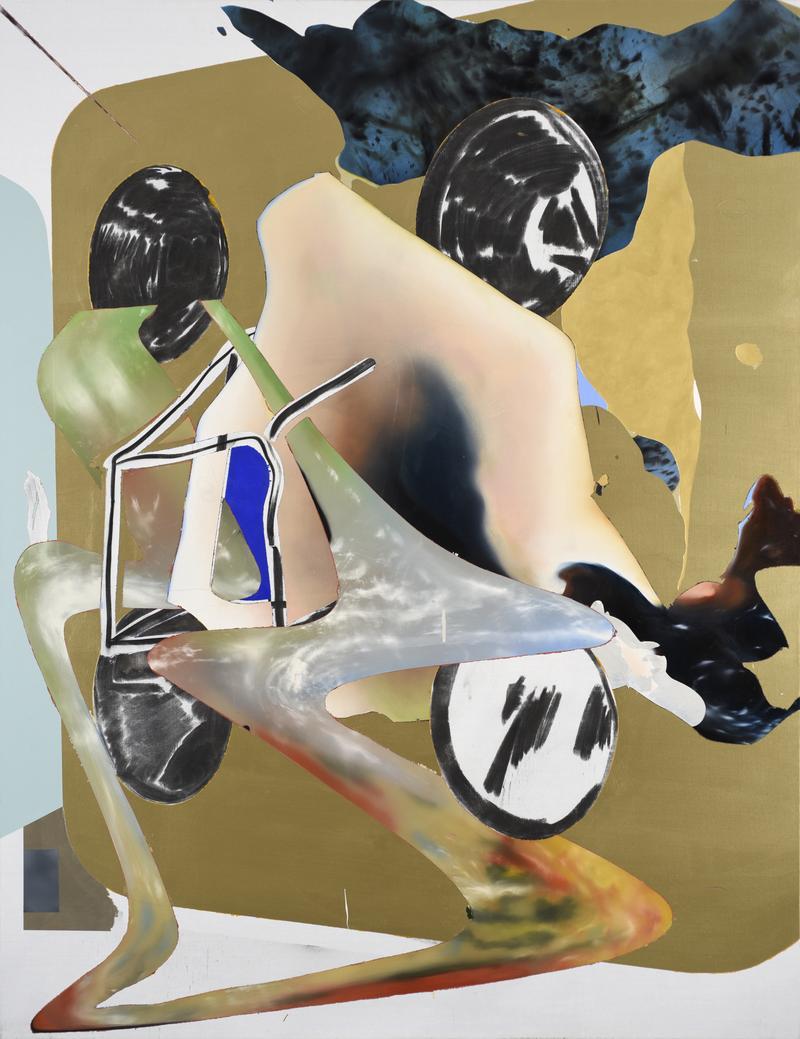
Volo Bevza: ‘Metamorphose 1,’ Metamorphose, 2018, oil and acrylic on canvas, 175 x 135 cm // Courtesy of the artist
NK: The work that both of you make is very complimentary, aesthetically. Is this questioning of “reality” also a theme you work with, Volo?
VB: Yes, absolutely. Some of the paintings I made for my show in Kyiv are over photos of the Ukrainian Revolution of Dignity in 2014, the Maidan. I painted directly on the photographs. It was interesting for me to work with print material, which is more of a document, and to have painterly actions and gestures confronting facts. I tried to add the emotions of the Maidan. One of the images is also from the January 6th Capitol attack in the US. I’m interested in how we perceive events that are far from us, ones that look similar but are different. I see the Maidan and the Capitol attack as matter and anti-matter—two elements that at core would destroy one another. The Capitol riot was anti-democratic, but Maidan proclaimed democracy against dictatorship. I also made some of my works with photogrammetry software. Vicky and I exchange ideas all the time.
NK: Was the Maidan influential for your work?
VB: Around that time, I was very interested in how people communicate. And, in 2016, when Trump won the election, I could not understand how this happened—that is, what the means or structures behind this were. I thought about Facebook algorithms, machine learning, how they shape perception and the kind of information that is conveyed. This is basically happening in Russia now, but it has skyrocketed. It’s more absurd. In 2015, I was studying stage design in Kyiv. My diploma work was a stage split into four parts. Each part could only communicate through screens, music and media, and these dissolved and deconstructed the messages moving from one space to the other. This slowly melted into my paintings. They also have this element of cutting things out, which resonates with the idea of echo chambers—of removed, isolated realities.
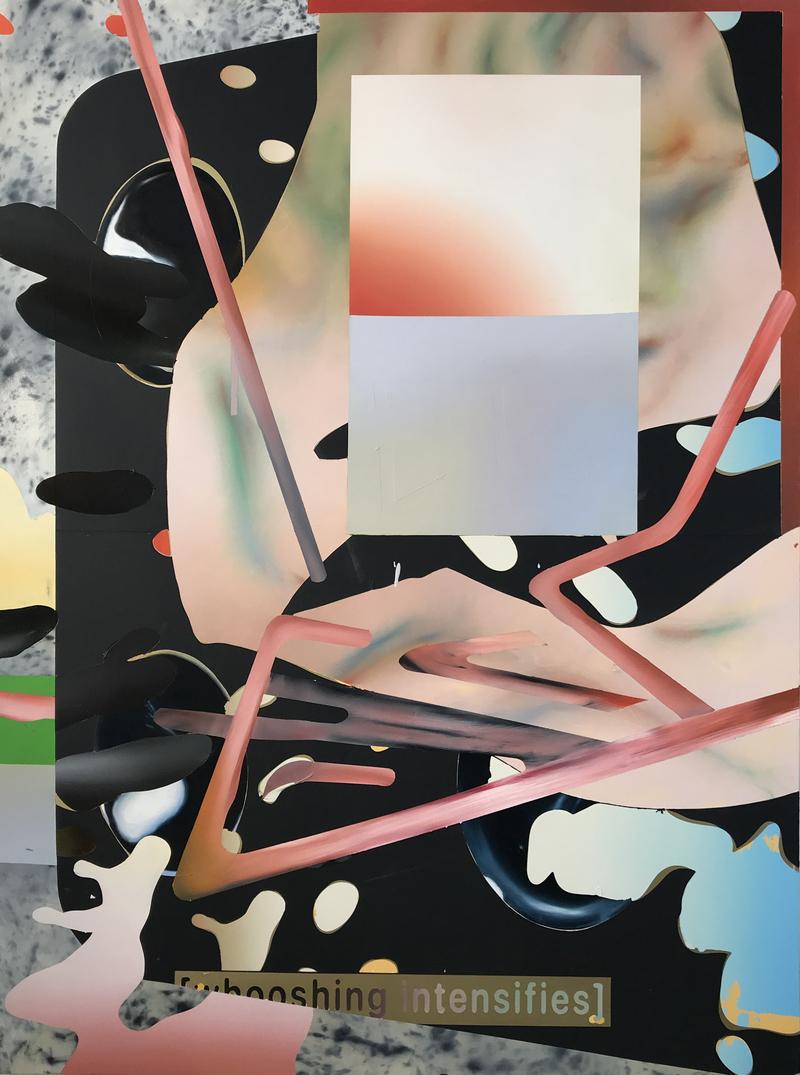
Volo Bevza: ‘Metamorphose 1,’ Metamorphose, 2018, oil and acrylic on canvas, 175 x 135 cm // Courtesy of the artist
NK: In the exhibition text for your solo show, ‘Soft Images,’ you state that your practice comes out of a different context than Western discourses. Could you expand on that?
VB: I don’t see “Ukrainian art” as something separate from “European art.” The culture is the same. By non-Western discourse, I mean the view towards Russian aggression. The Russian aggression towards Ukraine has been there all my life. But it was widely ignored in the West and not included in discussions of European security. Even five years ago, there were German TV shows asking whether Ukraine is a real country or a part of Russia. And, until recently, big newspapers, like The New York Times, still called Ukraine an “ex-Soviet” state. They don’t call Germany an “ex-Nazi” state, or Leipzig an “ex-DDR” city. But it’s completely different now. There is a lot of support from all of Europe.
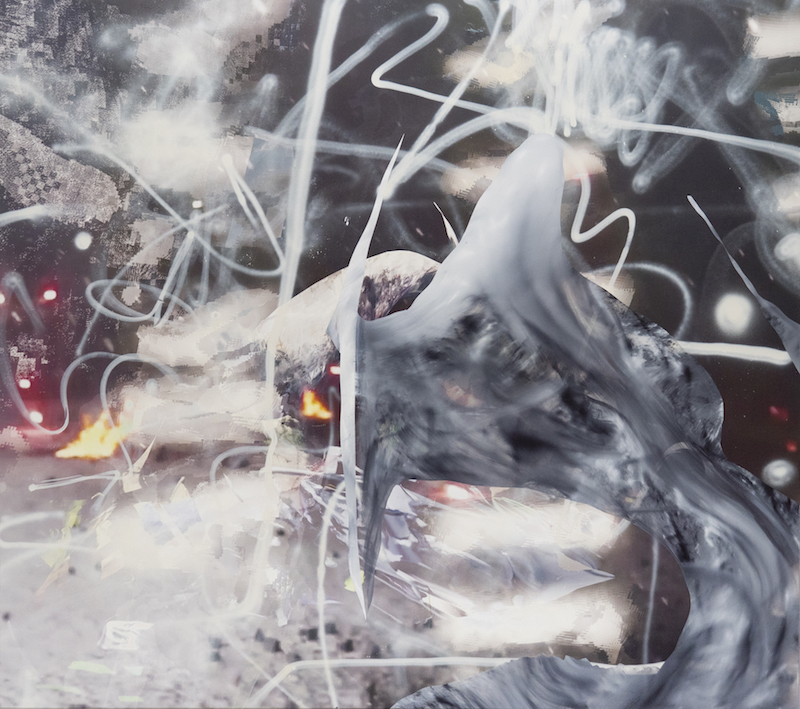
Volo Bevza: ‘Untitled,’ Soft Image, 2022, 160×180 cm, oil and UV-print on canvas // Courtesy of the artist
NK: With the long-term Russian aggression towards Ukraine, did you anticipate the invasion would happen?
VB: We had tickets to fly from Berlin to Kyiv on February 20th, and we weren’t sure until the last moment. But the day of, we decided to go.
VP: We decided not to be afraid of the idea of invasion, and instead to support the people in Ukraine. But we didn’t believe that this could happen. We did try to talk to our parents about what we’ll do if it does, but no one wanted to talk about it. Once it began, people thought that it would be a maximum of five days. It’s already been 12 days. Now, everybody believes it.
NK: Why do you think this was a surprise?
VB: No one believed it would be possible because they thought it would lead to the collapse of Russia, to problems no one would benefit from. It’s a total nightmare, and it doesn’t make any sense. There is no logic, and that scares me. The West and Ukraine are obeying the rules of war, of dignity. Putin doesn’t obey any rules. He attacks women, children, kindergartens, civilians. This is not a war, it’s terrorism. The West and NATO don’t get involved because no one wants a third world war. This is based on the idea of rules: if we don’t attack anyone, then the war won’t come. But Ukraine didn’t attack Russia. I’m scared of the irrationality.
VP: And something like 71% of Russians support this. It’s really scary.
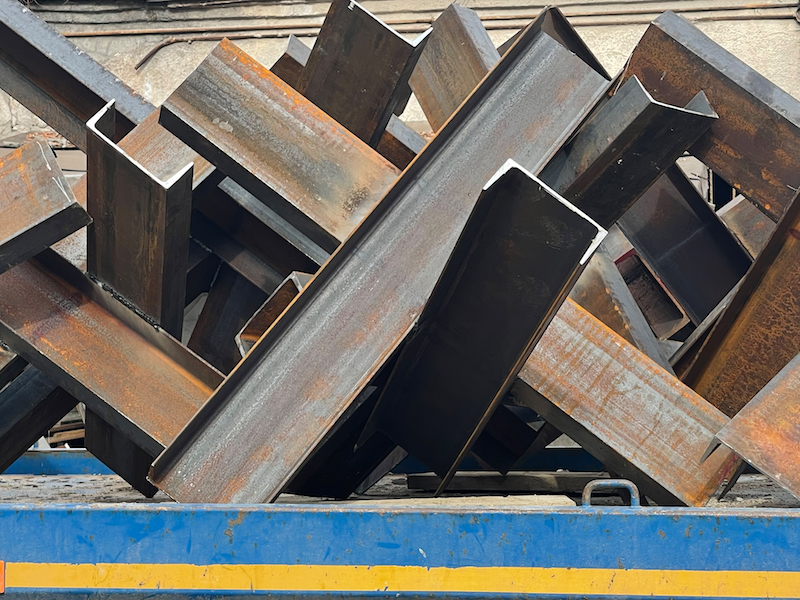
Documentation from the workshop building “hedgehog” anti-tank obstacles, Lviv, 2022 // Photo by Victoria Pidust
NK: The images you produce are simultaneously recognizable and unrecognizable. And now, this feeling occurs on a larger level, in a devastating way. Looking at the war, seeing that it’s irrational, there’s still an effort to find some structure to it.
VP: The feeling is happening between nations, regions. You wonder, what is on the surface, what is inside?
VB: What is true?
VP: Yeah, what is true?
VB: The question of truth is very current. For example, we know that 10,000 Russian soldiers are dead, and Russians know 1,000 Russian soldiers are dead. Where is the truth?
VP: Because of the internet, and technology, it’s a hard question. It’s like a dream world sometimes. When you turn on Russian news you can end up laughing. It’s so absurd, everything.
NK: Do you have any feelings about the future?
VB: I believe that democracy will win. But the question is: how high will the price be?




















